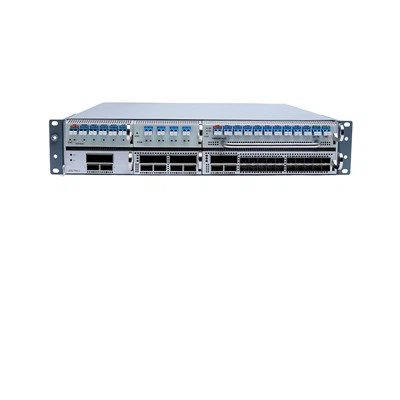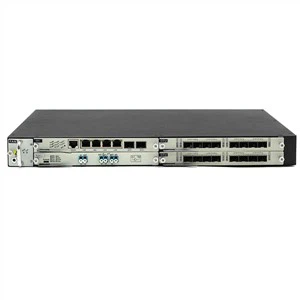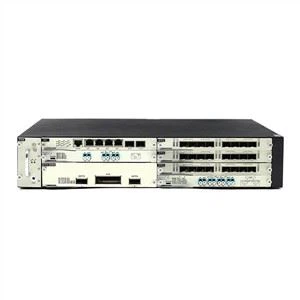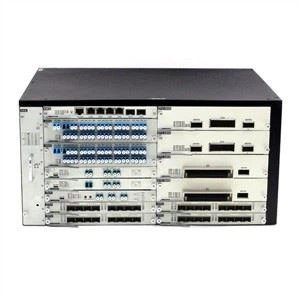SDH---Synchronous Digital Hierarchy is a set of standardized digital signal structure levels that can be used for synchronous information transmission, multiplexing, add and drop and cross connect. It can transmit synchronous signals on transmission media (such as optical fiber, microwave, etc.).
SDH optical transmission equipment can realize many functions, such as effective network management, real-time business monitoring, dynamic network maintenance, interworking between different manufacturers' equipment, etc. it can greatly improve the utilization rate of network resources, reduce the management and maintenance costs, and realize flexible, reliable and efficient network operation and maintenance. Therefore, SDH optical transmission equipment is a hot spot in the development and application of transmission technology in the world information field To people's extensive attention.
The transmission network is mainly divided into three layers: access layer, convergence layer and backbone layer.
The local transmission network is composed of transmission system, optical fiber network, pipeline / optical communication and convergence room, among which the transmission system refers to SDH / PTN / OTN and PON network.
The development of optical transport network

With the emergence of intelligent network elements supported by microprocessors, the combination of high-speed and large capacity optical fiber transmission technology and intelligent network technology makes SDH optical synchronous transmission network emerge as the times require.
SDH is called synchronous digital transmission system, which standardizes the frame structure, multiplexing mode, transmission rate level and interface code type of digital signal. At the same time, SDH improves the disadvantage of PDH which is not conducive to large capacity transmission.
SDH Rate
The rate level of SDH signal is expressed as STM-N, where n is a positive integer. At present, SDH can only support a certain n value, that is, n can only be 1, 4, 16 and 64. The most basic and important module signal is STM-1, with the rate of 155.520mbit/s. The higher level STM-N signal is obtained by inserting the basic module signal STM-1 between bytes. The rate of STM-4 level is 622.080mbit/s, STM-16 level is 2488.320mbit/s, STM-64 The rate of the level is 9953.280mbit/s.
SDH frame level | Load bandwidth(Kbit/s) | Transmission rate (Kbit/s) |
STM-0 | 50112 | 51,840 |
STM-1 | 150336 | 155,520 |
STM-4 | 601344 | 622,080 |
STM-16 | 2405376 | 2,488,320 |
STM-64 | 9621504 | 9,953,280 |
STM-256 | 38486016 | 39,813,120 |
SDH transmission system in the world has a unified frame structure, digital transmission standard rate and standard optical interface, which makes the network management system interworking. Therefore, it has good horizontal compatibility. It can be fully compatible with the existing PDH, and can accommodate all kinds of new business signals. It forms a global unified digital transmission system standard and improves the reliability of the network.
The frame period of SDH is constant, which makes the rate of STM-N signal regular. For example, STM-16 is equal to 4 times STM-4 and 16 times STM-1. However, the E2 signal rate in PDH is equal to 4 times of E1 signal rate. Therefore, SDH simplifies the multiplexing and division technology, and is convenient for up and down the road, especially suitable for large capacity transmission.
Advantages of SDH:
The simultaneous interpreting of SDH technology and traditional PDH technology has the following obvious advantages:
1. Unified bit rate: unified rate and optical interface.
2. Strong network management capability: abundant network management bytes are specified in SDH frame structure, which can provide the ability to meet various requirements.
3. Self healing protection ring: SDH equipment can also form a ring network with self-healing protection capability, which can effectively prevent the transmission media from being cut off and all communication services being terminated.
4. Byte multiplexing technology used in SDH Technology: the upper and lower circuits are convenient.
5. International unified digital transmission standard stm-n
6. It adopts synchronous multiplexing mode and flexible multiplexing mapping structure, which has wide adaptability
7. Arrange abundant overhead bits for network operation management and maintenance
8. Software is used for network configuration management and control, which is easy to expand. Software is widely used in SDH network to control and concentrate traffic on high-speed links and cross connection points. Software can control almost all cross connection equipment and multiplexing equipment in the network.
Disadvantages of SDH
1. The effectiveness of the system is low. The increase of effectiveness will reduce the reliability, and the increase of reliability will correspondingly reduce the effectiveness. One of the great advantages of SDH is that the reliability of the system is greatly enhanced (high degree of automation of operation and maintenance).
2. The mechanism of pointer adjustment is complex. SDH system can directly lower the low-speed signal from the high-speed signal, eliminating the multi-level multiplexing / demultiplexing process.
3. The influence of the large use of software on the system security.
A great advantage of SDH sampling two fiber bidirectional multiplexing section protection ring network is the use of self-healing hybrid ring network structure. SDH has the ability of resisting single fault, sampling bidirectional multiplexing protection ring. If one channel fails, it can be transmitted from another protection channel. The self-healing ability of ring network is a very important feature of SDH.
The network structure of self-healing ring can be divided into the following four types: unidirectional channel switching ring (1 + 1), bidirectional channel switching ring (1:1), two fiber bidirectional multiplexing section common protection ring and four fiber bidirectional multiplexing section common protection ring.
SDH network synchronization mode has the following characteristics:
(1) The transmission equipment between switching nodes of SDH network should work synchronously.
(2) SDH equipment is sensitive to the short-term instability of the clock.
(3) The clock of SDH equipment should have three working modes: synchronous tracking mode, holding mode and free oscillation mode.
(4) The 2Mbit / s signal carried by SDH transmission network is not suitable for synchronous reference timing signal because of pointer adjustment jitter.
(5) The dynamic topology application of DXC and ADM in SDH technology may lead to timing loop. It must be noted that no matter which external reference source is tracked, timing loop can not appear in any case. When the timing loop can not be eliminated, it is better to identify only one external reference source, which needs special attention in networking.
Because SDH has a variety of network topologies, its network is very flexible. It can enhance the network monitoring, operation management and automatic configuration functions, optimize the network performance, but also make the network operation flexible, safe and reliable, so that the network functions are very complete and diversified.
SDH has the performance of transmission and switching. Its series of devices can be freely combined by functional blocks to realize the network of different levels and topologies, which is very flexible.
Future development and Prospect of SDH Technology:
1. Development of SDH network management software
SDH is a complex system and network controlled by software, which draws lessons from the latest research results of computer science. A flexible network management system with comprehensive consideration and advanced technology is the key to success or failure of SDH network technology.
2. The development of ultra high speed optical fiber transmission technology
Due to the bottleneck effect of high-speed electronic circuits and optoelectronic devices, it is difficult for the traditional optical time division multiplexing (TDM) optical fiber communication system to develop upward when the transmission rate reaches 2.5gb/s. The development of broadband services puts forward higher requirements for the transmission network. Therefore, it is imperative to adopt the latest OTDM (optical time division multiplexing) and DWDM (dense wavelength division multiplexing) technologies The wavelength interval of division multiplexing is smaller, with 0.2 nm or its integral multiple as the wavelength interval.
3. SDH application transmission media expansion
In most cases, the medium of transmission network is mainly fiber-optic, supplemented by wireless. In wireless communication, microwave is an important means of communication. SDH microwave transmission system is compatible with the existing PDH microwave system. It adopts the original channel interval of pdh140mb / s system, i.e. 30MHz and 40MHz, but it needs to transmit higher bit rate.
4. SDH is applied to broadband access technology
As a transmission technology of B-ISDN, SDH must be applied to access network. For example, in the future, switches will be able to provide optical trunk lines based on SDH standards; subscriber lines of switches will develop towards V5, and will be able to provide V5.3 interfaces based on SDH in the future. In this way, SDH signals can be directly sent to the user / network interface (UNI) from the switcher.
SDH has become the mainstream of transmission network development because of its obvious advantages. The combination of SDH technology and some advanced technologies, such as WDM, ATM and IP over SDH, makes SDH network more and more important. SDH has been listed in the application project of high-speed communication network in the 21st century. It is recognized as the development direction of digital transmission network in the telecommunication industry, and has a great commercial prospect.


If you need anything, you can contact HTF Zoey.
contact:support@htfuture.com
Skype:sales5_ 1909,WeChat:16635025029





















